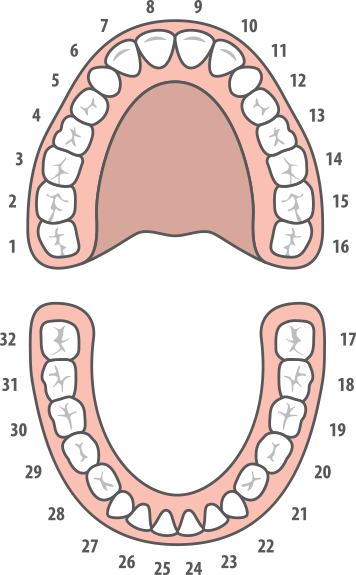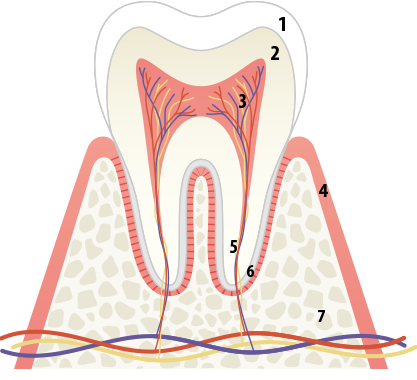Delta Dental glossary
What your teeth look like
-

-
7, 8, 9, 10, 23, 24, 25, 26
Centrals and laterals (incisors) are the four front teeth on your upper and lower jaws (also called incisors).6, 11, 22, 27
Cuspids (canines) are the teeth near the front of your mouth that come to a single point.4, 5, 12, 13, 20, 21, 28, 29
Bicuspids (premolars) are the teeth with two rounded points located between your cuspids and molars.1, 2, 3, 14, 15, 16, 17, 18, 19, 30, 31, 32
Molars are teeth with a broad chewing surface for grinding food and are located in the back of your mouth.
What a tooth looks like

1. Enamel is a hard, shiny substance that works as a barrier to guard the inside parts of the tooth.
2. Dentin makes up the largest part of the tooth. Dentin is like bone and is almost as hard as enamel.
3. Pulp is where each tooth's nerve endings are.
4. Gum is the flesh that surrounds the roots of your teeth.
5. Nerve is a bunch of fibers that carry messages to your brain and other parts of your body. It tells you when your teeth are cold or hot or when they hurt.
6. Cementum holds the root of each tooth to your jawbone.
7. Jawbone is the bone of your upper or lower jaw.
More dental definitions
Caries: Tooth decay, which leads to a cavity.
Orthodontics: Straightening or moving misaligned teeth or jaws, usually with braces.
Pediatric dentist or pedodontist: A dentist who treats children from birth through their teen years.
Plaque: A sticky substance containing bacteria and acids that collects on your teeth and can cause cavities. Get rid of plaque by brushing and flossing every day.
Retainer: A device that helps keep your teeth straight after you have braces.
Sealant: A plastic material that covers the grooves in your teeth to keep out food and help prevent plaque.
